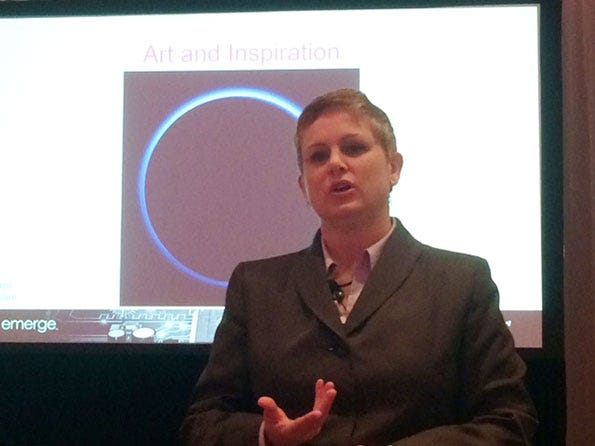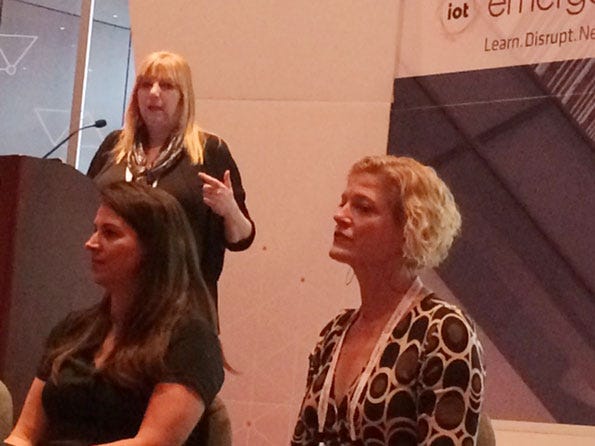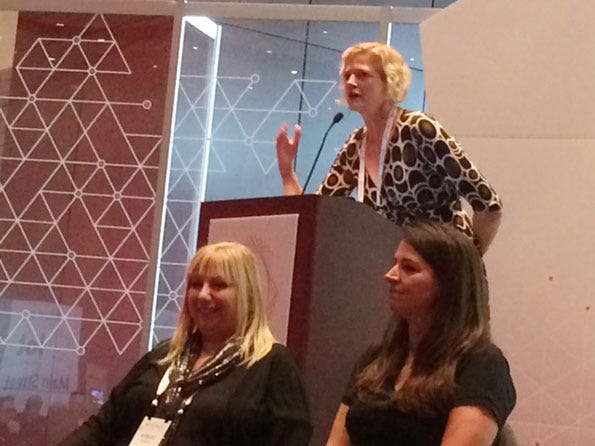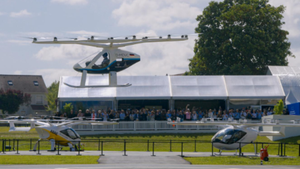Insights from the Women of IoT Emerge
The first ever IoT Emerge—held in Chicago the first week of November—had a conference track specifically dedicated to women in IoT.
December 2, 2016

By Candace Roulo
When working on IoT projects, it is important to figure out which data is most important, so you can start tracking the data via sensors, said Marcia Elaine Walker, principal consultant, manufacturing, of SAS, one of the speakers at IoT Emerge. “For companies that collect a lot of data, but are unsure of what’s actually useful, I recommend applying analytical models to determine where relationships exist and which variables can best predict the outcomes that are important to you,” said Walker in a session titled “Lessons from NASA’s Mission to Pluto in the session IoT Strategy: Engineering, Science and Art.” “Once you determine which data points matter for your particular outcome, you can focus your data collection efforts more effectively.”
For companies that collect a lot of data, but are unsure of what’s actually useful, I recommend applying analytical models to determine where relationships exist and which variables can best predict the outcomes that are important to you, — Marcia Elaine Walker

Marcia Elaine Walker gives an entertaining and thought-provoking presentation at IoT Emerge.
This often means team work, and the people that make up the teams need to collaborate with one another.
“For example, an effective team may comprise of a data scientist, who knows how to do the hard math; a subject matter expert, who can establish a hypotheses about key factors; plus a hardware expert, who knows the characteristics of the relevant data,” explained Walker. “Modern analytics packages are becoming easier to use.”
In order to work on an effective IoT project team, listening skills are important, especially when teams are made up of a blend of people from diverse disciplines.
“Typically specialists develop their own insider language and assumptions, and they communicate well with the familiar,” explained Walker. “IoT introduces the unfamiliar, and this leads to abundant opportunities for assumptions and miscommunication.
IoT introduces the unfamiliar, and this leads to abundant opportunities for assumptions and miscommunication, — Marcia Elaine Walker
“For example, at a recent tradeshow I witnessed a software architect ask a manufacturing network manager whether a particular piece of code could theoretically run on a gateway,” added Walker. “The answer was, ‘Yes.’ But, that question was ineffective and the answer was incomplete. A better question would have been, ‘If I’m trying to analyze pieces of data from multiple sensors in multiple locations in your factory, what’s the best way to go about that?’ That open-ended question would have let his colleague explain the spaghetti-bowl world of wires in that particular factory, and how they were often moved and reconfigured.”
Best practices for collaboration
Since working on IoT projects come down to collaboration by a diverse group of people, I asked Walker for some best practices that can be applied to ensure teams work well together (this can be applied to other projects, not just IoT projects).
Walker’s best practices & tips for collaboration include:
Build trust with informal networking. Create structured space for informal networking and idea sharing. For example, we’ve started a monthly “IoTea” where I work. It presents an opportunity for people from a variety of departments to get together for half an hour each month to chat about what we’re working on. There’s no formal agenda, no reports, no slide decks – just hot beverages and conversation. The trust built up in that half an hour and the opportunities for cross-team innovation have been productive and satisfying.
Ask what’s in it for you? Ask team mates how they are being measured. Understanding from the start of a project the key metrics that make each team member successful in the eyes of their management helps to quickly establish goals and objectives that matter. With everyone pulling in the same direction, meaningful results often materialize more quickly. For example, I asked a marketing colleague recently about how she was measured. I learned that her key performance metric involved generating more leads from webinars. So, instead of asking her to support an on-site event, I helped her secure a webinar host.
Seek creative potential. My biggest inspiration while working on IoT projects is the “space between the lines” – the area that’s filled with the possibility for innovation. Lots of people work on the known, but it’s important to become comfortable working on the unknown. I often ask, “What am I not seeing here?” Then I look at it from a different angle, and that can help me visualize a creative, new solution.
During the panel discussion session Connected, Smart and Resilient City Blueprints: How and Where to Start and Grow Public and Private Sector IoT Initiatives, Kristy LaFollette of FavoriteMedium.com; Stephanie Hayden, CEO & vision architect of Vision Architecture Inc.; Linda Drabik, founder of IoT NY Meetup, Marencik Group; Ayelet Baron, author, AyeletBaron.com; and Alicia Asín, CEO, co-founder, Libelium discussed the user being at the core of IoT.

Ayelet Baron, author, discusses how IoT brings people together and improves lives. Also pictured here are Linda Drabik, founder of IoT NY Meetup, and Kristy LaFollette of FavoriteMedium.com.
“IoT should always start with our lives,” said Baron. “What’s more important than integrating the benefits of technology into life on this planet? Why have smart toasters, refrigerators or cities, if they don’t add value to life? For too long, we have been leading with technology where our opportunity is to integrate the beauty of technology to create a more unified life. I don’t want to talk about the best solutions. I want us to focus on the people who understand that water is life and are looking at massive opportunities to bring fresh, clean water to people and animals around the planet who need it to live and contribute to our world.”
I want us to focus on the people who understand that water is life and are looking at massive opportunities to bring fresh, clean water to people and animals around the planet who need it to live and contribute to our world, — Ayelet Baron
Usually a crisis or disaster is the catalyst for people to come together around a shared purpose, however, IoT can turn that around, and bring people together before such events happen.
“There is so much opportunity for us to architect a new purpose-driven world where we connect human-to-human and things simply help us achieve that purpose,” said Baron. “I have worked around the world in tech and have experienced the beautiful power of technology to change lives from slums to large cities. But it takes us tapping into our imagination and unleashing experiences that impact lives rather than just profits. A 21st century organization sees their opportunities on the edges and understands how to use technology and people to tap into the next big thing for all of us.”
4 Wise I’s of IoT
Also during the panel discussion, LaFollette shared with attendees her list if “4 Wise I’s,” and why these four I’s are a must when working on IoT projects.
No. 1: Be inventive — Keep thinking about IoT and how it affects you outside of the workplace. When asked how do you remain inventive in this day and age, LaFollette shared that she used to think that being inventive mostly required intelligence and guts, but she now thinks listening can be a catalyst to being inventive.
“Not just listening to others around you, but the day-to-day sounds,” explained LaFollette.
“Inventiveness is undeniably linked to inclusivity, because if you are only working within very limited requirements or not having a good understanding a target users’ needs, you are unlikely going to invent something for yourself. And it may fulfill on a set of needs for that target user, but it probably won’t blow their minds.”
Inventiveness is undeniably linked to inclusivity, because if you are only working within very limited requirements or not having a good understanding a target users’ needs, you are unlikely going to invent something for yourself, — Kristy LaFollette
LaFollette chose the word “inventing” instead of “innovation” for her list for a specific reason.

Kristy LaFollette of FavoriteMedium.com created the “4 Wise I’s” when asked to speak at IoT Emerge.
“The word ‘innovation’ is so overly used, and it means nothing,” said LaFollette. “Innovation is not a characteristic or a value, it’s an outcome. Being inventive requires one to constantly try new things, read up on new technologies, listen to a new or different view point.”
No. 2: Seek inspiration — You can get distracted by the day to day, so it’s important to be inspired. When asked what inspires her, LaFollette said that inspiration comes from meeting people who are truly committed to making change in not only the technology industry, but helping make the world a better place.
“People who volunteer their time to help other people in need,” explained LaFollette. “I spent enough years working for companies who cared more about profits and investing little into sustainable business practices, and I’m lucky I work with a services firm where we can choose our clients based on our collective values. I am lucky to work with people who care about things I care about.”
She’s also inspired by people working in a corporate environment that are able to make things happen.
“It’s harder to take risks and get ideas out to be tested in bigger corporate environments, so when I meet people who are able to do that, that is inspiring,” said LaFollette.
No. 3: Strengthen intuition — This is undervalued in business, yet it’s so helpful if you can hone your intuition.
“Intuition is something that is not represented as a something of importance nor strength in business, probably because it infers subjectivity and not using logic,” explained LaFollette. “For me, some of the most successful business people I know have powerful intuition, not just a pedigree or a good network. Intuition has served me greatly because I rely on it when getting to know people, understanding the timing and nuances when negotiating contracts, and knowing when to stand firm on a position vs. considering how to compromise. Intuition isn’t just a ‘woman thing.’ I know a lot of men who use it well. It is closely linked to social intelligence, being able to read other people’s energy, their body language, but it’s more.”
No. 4: Live inclusively — Overall the IoT landscape is still not very diverse. We need to remember it’s not just about millennials.
LaFollette pointed out that IoT is a collection of different industries; it’s not really one industry.
“If we just look at the U.S. alone, there’s a huge opportunity to create some amazing IoT systems by bringing people together from different backgrounds and different ages, particularly when we are looking at urban planning and the whole Smart Cities movement.”
LaFollette said that to her IoT is a new way of thinking and less about the technologies.
“Thinking comes from people and innovative thinking comes from people who bring diverse points of view together,” explained LaFollette. “At Favorite Medium, we have a team that is both gender balanced and a mix of ethnic backgrounds. This has served not only our understanding of different cultures, but how we can make better products. This is why I joined the company more than three years ago. I wanted to work with people who were not like me and who I could learn from.”
Importance of culture, mentors
There was a treat the last day of IoT Emerge — a luncheon with keynote speaker Sandy Carter. A leading pioneer in the digital business revolution, Carter is founder, CEO and brand ambassador for Silicon Blitz. During the luncheon she discuss the her recent research project on women founders, took a closer look at women founders in technology, and wrapped up the luncheon by answering audience questions.
Carter discussed how important culture and mentors are for girls and women.
“Ninety-eight percent of respondents talk about the impact of the family,” said Carter. “The first action is to start young and have the entire family involved in discussing the high-tech fields women have a career in. It’s also important to focus on entrepreneurship. There are so many programs on the West Coast of the U.S. about becoming an entrepreneur, and many of these programs start early [during K-12 education],” said Carter. “The question is how do we get this culture in all schools in the country?”
Carter referenced a program called “Girls Who Code.” This is a great example of a positive culture that can be in schools and the community. The mission of the program is to close the gender gap in technology.
According to the Girls Who Code website, when girls learn to code, they become change agents in their communities — whether it’s a game to illustrate the experience of an undocumented immigrant or a website to provide free college prep, our girls create technology that makes the world a better place.
Carter also discussed how important mentoring is to girls. She advises that a mentor is chosen wisely, and everyone should have a board of mentors, so you are not learning from one person, but everyone on the board. Carter also said that it’s important to treat everyone as a mentor, and that you can learn from everyone.
IoT Emerge sponsors
A special thanks goes out to Diamond, Gold, Silver and Bronze sponsors: AVNET, Autodesk, LNS Research, SAP, Eaton Lighting, RF Digital, Burns & McDonnell, Crowdstory and US Green Building Council.
You May Also Like






